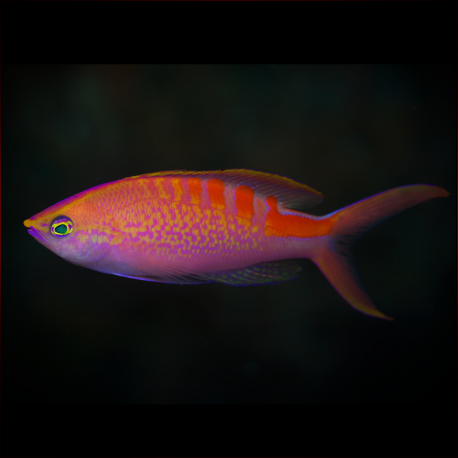More info
Datasheet
| Minimum Tank Size | 400 litres / 105.67 US gallons |
| Maximum Size | 12.0cm / 4.72inches |
| Reef Compatible | Always reef safe |
| Temperament | Docile but might be aggressive towards similar species of same gender |
| Temperature | 22.2°C / 71.96°F - 25.6°C / 78.08°F |
| Specific Gravity | 1.020-1.025 |
| Carbonate Hardness | 8-12 |
| pH | 8.1-8.4 |
General Description
Lori's anthias (Pseudanthias lori) belongs to the Serranidae family, specifically under the subfamily Pseudanthias. These colorful fish are native to the Indo-Pacific Ocean, ranging from Christmas Island to the Tuamoto Islands, with varying shades of orange and pink.
Aquarium Suitability
Suitable for specialized aquariums, Lori's anthias requires a minimum tank size of 400 liters. They are known to be docile yet may show aggression towards similar species of the same gender, highlighting the need for careful consideration when selecting tank mates.
Care and Hardiness
Being hermaphroditic, these fish have the unique ability to change gender when required. They exhibit average hardiness but can be sensitive during transportation, necessitating a gentle acclimatization process into the aquarium.
Reef Suitability
Pseudanthias lori is deemed reef-compatible and always reef safe. To thrive in a reef setting, they must be provided with ample hiding spots, typically amidst live rocks.
Aquarium Setup
For optimal care, it is advised to maintain dimmed lighting in the aquarium, replicating their natural habitat conditions. Offering a varied diet that includes small crustaceans like krill, mysis, and artemia, along with zooplankton such as Cyclops and pods, is vital for their overall well-being.
Behaviour
These anthias are known to be shy and sensitive, necessitating a calm and peaceful community tank. In group settings, one male can coexist with multiple females in larger tanks, although aggression might arise if space is limited.
Feeding and Diet
Pseudanthias lori requires frequent feeding throughout the day, especially when newly introduced into the tank. Initially, they may struggle with frozen foods but can adapt over time to accept fish flakes and a diverse diet.
Dimorphism
The species is capable of changing gender from female to male as needed, ensuring a dynamic social structure within the aquarium setup.
Habitat and Distribution
Found in the East Indian Ocean, Australia, Indonesia, and various parts of the East and Central/West Pacific regions, these anthias prefer habitats with good hiding places, resembling their natural environment for a stress-free living experience.

